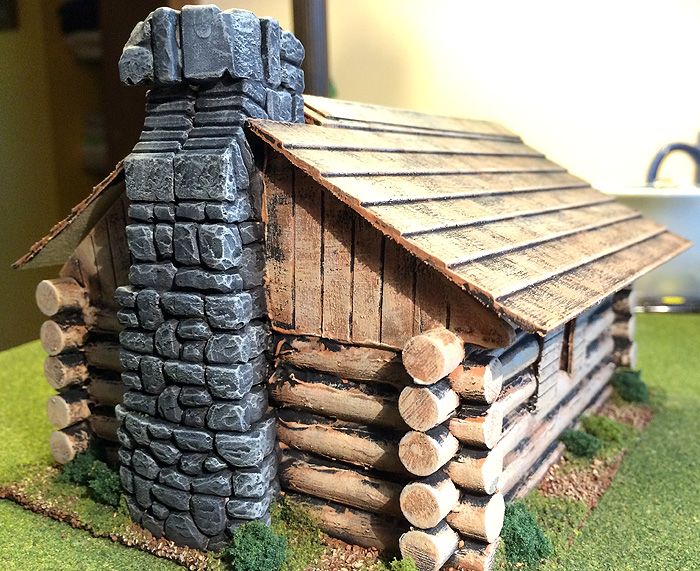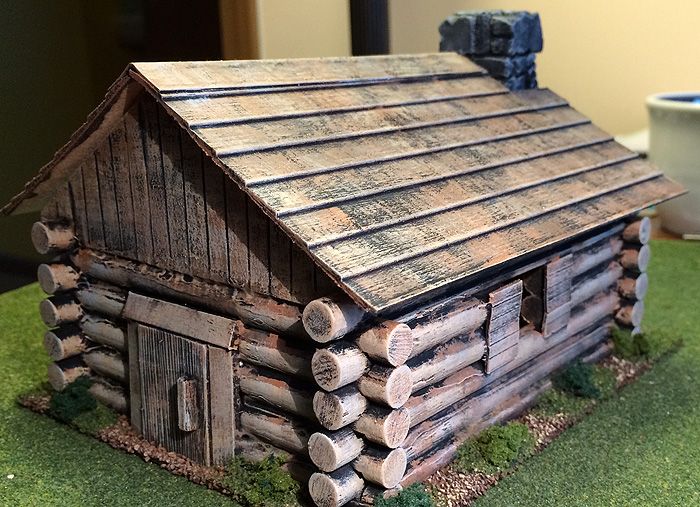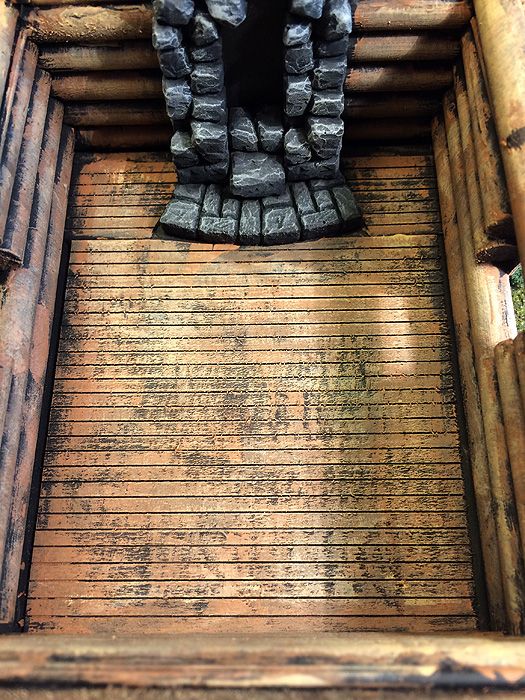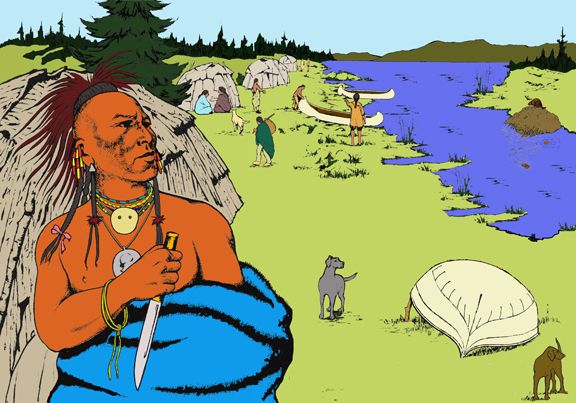We are in the home stretch of our second playtest of the Beaver Wars in Ohio campaign rules. I'm very satisfied with this version of the campaign framework. The turn by turn record keeping is minimal, and is easily handled by the GM. My players have said that it would be very easy for the GM to be a player in this campaign. There really is no advantage to what he "knows" or doesn't. I know from past experience that, when a GM doesn't get to play in the campaign as well, it is harder to keep up a level of interest that you would have as a player. The Beaver Wars allows the GM to take on the role of a tribe, as well, and get the same enjoyment out of it that his players are receiving.
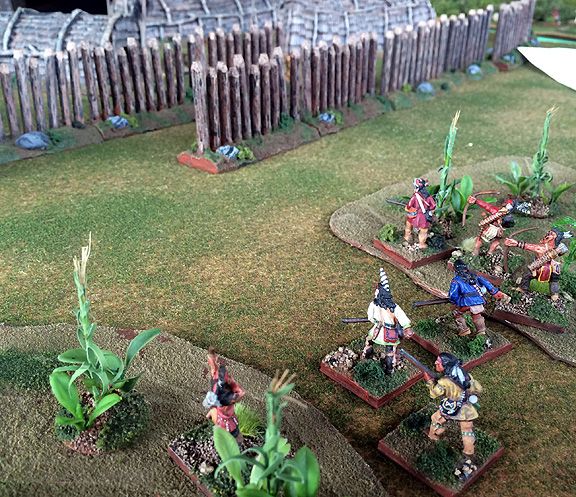 |
| Seneca warriors rush the gates of a Neutrals town in "Hold Them at the Gates" |
We had four battles generated on turn 7, and they were bloody and brutal ones, at that! The way the
Song of Drums and Tomahawks rules work, battles usually end when one side falls below 50% of its starting forces and their morale begins to falter. It is rare when forces fight to the last man (just as it was rare in history). One side will usually run away before that happens. The campaign's "Scenario Victory Point (SVP)" system also encourages a player who's down to his last few guys to not futilely sacrifice them, as he will generally just give his opponent even more SVPs. Players are free to voluntarily withdraw their forces so that they can "live to fight another day."
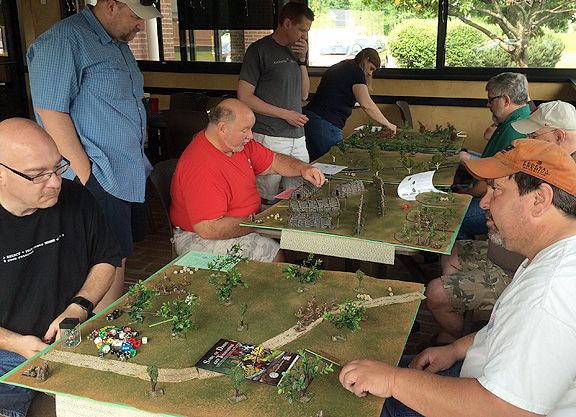 |
| Cheers rang out in the pizzeria's party room as the battles went down to the bitter end on Turn 7 |
That said, we had two of our four battles go down to the last man, this turn. If I'm not mistaken, this was the first time it has happened all campaign that both sides were whittled down to a single warrior. I know my Erie tribe had a battle that went down to a 2-on-2, and we have had forces entirely eliminated. However, to have two games come down to the last swing of a tomahawk was fairly unusual, as well as very gripping for my players. There were mighty cheers resounding in the local pizzeria's party room that Saturday morning. As GM, it was gratifying to me to see them still enthusiastic about seizing victory after seven turns of campaigning.
One of the games that went down to the final deadly swing pitted our second and third place tribes, Dave's Mohawk vs. Joe's undefeated Shawnee. The scenario was
"Collision on the Forest Path," and is a fairly straight-forward encounter scenario. The opposing tribes have sent raiders towards each other's lands, and these forces bump into each other on their way. Dave knew that the Shawnee warriors were deadly Marksmen (Joe had armed most of his warriors with that Trait), so closed quickly to hand-to-hand to minimize that advantage. Three Mohawk fell quickly, though, and Dave began to worry that the Shawnee reputation for prowess in battle was well-deserved. He battled back, though, and soon enemy warriors began to fall. The Mohawk were the first to fall below half, and saw their battleline fragment as warriors panicked momentarily. The Mohawk chieftain kept them together, though, and soon the Shawnee faltered as their losses fell below half. Warriors kept falling on both sides, though, until only two were left. They traded blow for blow until, at last, the Shawnee fell. The Mohawk held the field, although at great cost. The final score was 15-11, a Mohawk victory (and the Shawnee player's first battlefield defeat).
 |
| The Miami warriors are caught by surprise while reclining around their campfire, but soon turned the tables on their Kickapoo attackers |
The 18 scenarios that will be included in the Beaver Wars in Ohio campaign rules feature a mix of setups and tactical puzzles. While setting up, the Miami player complained that "Blood on the Campfire" was too disadvantageous to the defender. Most of his forces begin prone around a campfire, with one alert guard keeping watch. The Kickapoo player decided to make it even tougher on the Miami by purchasing the Sprinter Trait for a number of his warriors. This enabled them to rush the prone warriors and attack before they had a chance to rise to their feet. Both shook their heads ruefully at the forthcoming slaughter. Both were surprised by how the game turned out. Yes, the Miami did lose a few drowsy warriors to quick attacks. However, when they counterattacked the Kickapoo leader, who'd entered combat, they slew him, sending panic rippling through the attackers' ranks. The momentum had shifted, and it was Kickapoo warriors who were being chased down and killed by Miami roused from their evening rest. Both players joked that Miami must be VERY grumpy in the morning, and it is probably best to leave them alone until they've had their morning coffee! The Miami scored their first Major Victory of the campaign, winning 11-3.
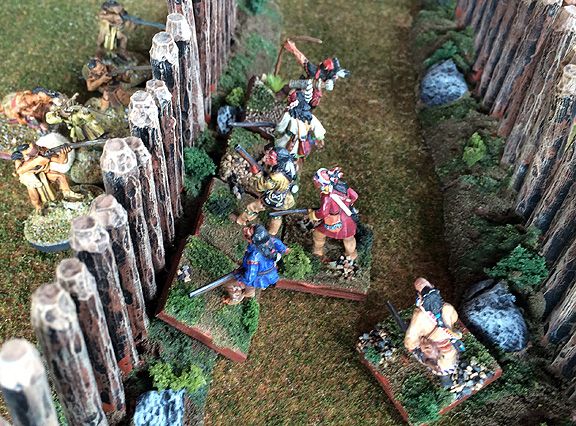 |
| Seneca warriors flood the passageway into the Neutrals town, but stop to exchange shots with the town defenders |
One of the strategic aspects of the campaign is in choosing which "Hunt" or "War" card your tribe will play for this turn. Some, like the Mohawk, have played mostly Hunt cards, which score the tribe more Beaver pelts (one of the three categories tribes are competing in for the victory). Others prefer to be able to select their opponent and choose War cards. The Seneca have chosen that strategy more often than not (and somewhat historically, too!). They played their highest War card this turn so that they could once again attack the Neutral tribe, which was still in 1st place. I rolled up
"Hold Them at the Gates" as the scenario for Mike and Keith. This features a struggle for the entrance of the defender's town. Indian towns during this period were usually encircled by palisades that often did not have gates. Instead, they had a looping entranceway that attackers would be exposed entering. Mike's Seneca charged quickly into the entrance, but then took up position along the palisade, firing into the town at the Neutral defenders collecting to oppose them. The Neutral charged to shove them back from the palisades, but lost several warriors. They fell back to defend the longhouses. The Seneca dithered for a few moments before charging into the town and engaging the Neutrals. A couple Seneca braves fell, but when their full might got to grips, the Neutrals began to fall in greater numbers. Soon, the Neutral force broke away from contact as they fell below 50%. Keith chose to have his warriors keep running, even though his losses had not fallen that low. This surrendered the town to the Seneca, who scored a Major Victory, 19-2.
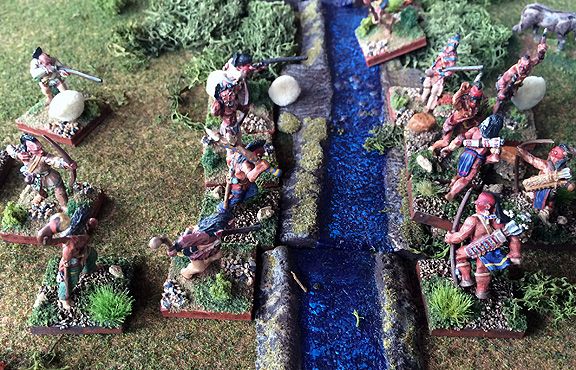 |
| A small creek runs red with slaughter as a party of Susquehannock hunters is attacked by Honniasont youths in "A Shot Rang Out" |
The final scenario pitted the Honniasont against the Susquehannock. In this battle, a party of Susquehannock hunters have shot a deer and are gathered around it to butcher the kill. They are surprised by a force of Honniasont Youths led by a veteran chieftain, who challenge their rivals right to hunt on their ground. A steep-bedded, but shallow, creek divides the two parties. The youths raced to attack the trespassers in hand-to-hand immediately. Meanwhile, the Honniasont preferred to shoot at their enemies from across the creek. Although the firearms of the Susquehannock caused losses in the more numerous Honniasont, the teens were able to gang up on the hunters and began to kill a number of them, as well. The enthusiasm of the Honniasont youths enabled them to withstand the worrisome sight of their friends' and companions' deaths. Even when their numbers fell below 50%, many remained to continue the fray as stalwart as veteran braves. Soon, the Susquehannock numbers dropped below half, and their hunters began to leave the field. The youths remained steadfast, and dealt killing blow for killing blow. Amazingly, it came down to the leaders of each force, trading blows in hand-to-hand. The Honniasont avenged his slain youths, and felled the leader of the Susquehannock hunting party. The spirit of the deer was kept in great company by the numbers of the brave slain. The score was tied at 15-15, but victory was awarded to the Honniasont as they had possession of the field.
In the end, both our 1st and 2nd place tribes lost this turn -- the 1st-place Neutrals losing badly. How did this affect the standings after 7 turns? The Neutrals dropped to a tie for 1st place with the Shawnee. Instead of being 3 1/2 points out of first place, the Mohawk closed to within 1 1/2 points of the lead. The Seneca jumped over the 4th place Kickapoo to be next on the Leaderboard. Here are the overall standings, followed by each individual category.
|
Tribe
|
Place
|
Victory Points
|
|
Neutrals
|
Tied 1st
|
24.5 points
|
|
Shawnee
|
Tied 1st
|
24.5 points
|
|
Mohawk
|
3rd
|
22 points
|
|
Seneca
|
4th
|
16 points
|
|
Kickapoo
|
5th
|
15 points
|
|
Miami
|
6th
|
12.5 points
|
|
Susqehannock
|
7th
|
11 points
|
|
Erie
|
8th
|
7 points
|
|
Honniasont
|
9th
|
3 points
|
|
Tribe
|
Prestige Points (PPs)
|
|
Neutrals (Keith Finn)
|
16 (5 MajV, 1 MinD)
|
|
Shawnee (Joe Merz)
|
16 (3 MajV, 3 MinV, 1 MinD)
|
|
Mohawk (Dave Welch)
|
12 (3 MajV, 1 MinV, 1 MinD)
|
|
Seneca (Mike Stelzer)
|
12 (2 MajV, 3 MinV)
|
|
Kickapoo (Andy Swingle)
|
10 (3 MajV, 1 MinD)
|
|
Miami (Jenny Torbett)
|
8 (1 MajV, 2 MinV, 1 MinD)
|
|
Susquehannock (Steve Phallen)
|
5 (1 MajV, 2 MinD)
|
|
Erie (Mike Demana)
|
5 (1 MajV, 2 MinD)
|
|
Honniasont (Bruce Adamczak)
|
3 (1 MinV, 1 MinD)
|
|
Tribe
|
Scenario Victory Points (SVPs)
|
|
Shawnee (Joe Merz)
|
97
|
|
Neutrals (Keith Finn)
|
92
|
|
Seneca (Mike Stelzer)
|
79
|
|
Mohawk (Dave Welch)
|
76
|
|
Miami (Jenny Torbett)
|
66
|
|
Kickapoo (Andy Swingle)
|
62
|
|
Susquehannock (Steve Phallen)
|
60
|
|
Erie (Mike Demana)
|
38
|
|
Honniasont (Bruce Adamczak)
|
30
|
|
Tribe
|
Beaver Pelts
|
|
Mohawk (Dave Welch)
|
43
|
|
Neutrals (Keith Finn)
|
37
|
|
Shawnee (Joe Merz)
|
35
|
|
Kickapoo (Andy Swingle)
|
32
|
|
Susquehannock (Steve Phallen)
|
25
|
|
Miami (Jenny Torbett)
|
22
|
|
Erie (Mike Demana)
|
22
|
|
Seneca (Mike Stelzer)
|
22
|
|
Honniasont (Bruce Adamczak)
|
19
|
